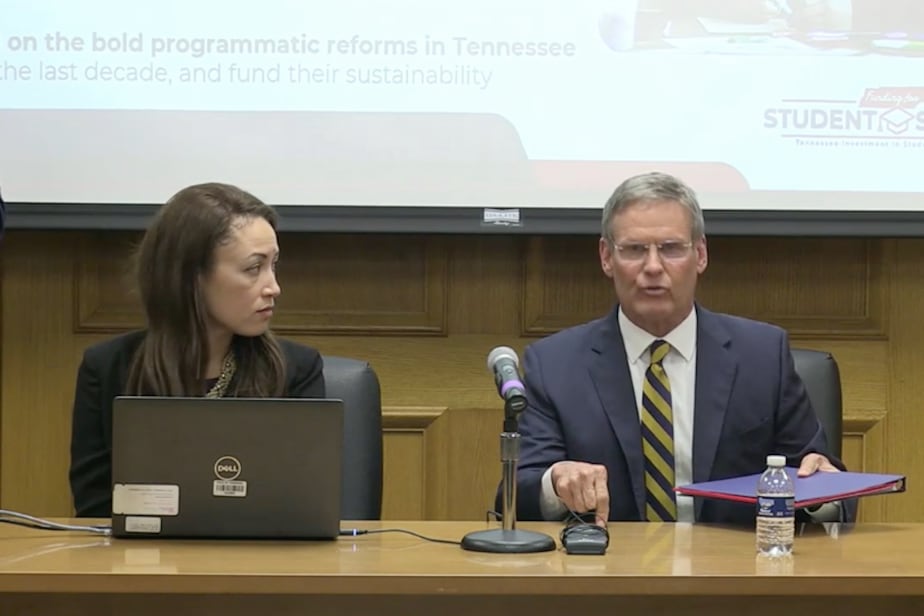Gov. Bill Lee has unveiled his proposal for overhauling K-12 funding in Tennessee, including a base of $6.6 billion to provide per-pupil funding to educate nearly 1 million public school students and $1.8 billion in extra support for students needing the most help.
The governor wants another $376 million for programs to improve literacy in kindergarten through the fourth grade and strengthen career and technical education for older grades.
He also wants to set aside $100 million to reward schools whose students demonstrate success in learning to read and in college and career readiness.
Lee outlined the first details of his long-awaited TISA plan, which stands for Tennessee Investment in Student Achievement, on Thursday with his education chief, Penny Schwinn. Beginning in 2024-25, the state would provide $6.3 billion, and local governments would contribute $2.5 billion.
If the legislature approves the plan, Tennessee would join 38 other states that have some type of student-based funding model. Lee wants TISA to replace Tennessee’s 30-year-old funding formula called the Basic Education Program, or BEP, which is a mostly resource-based model that’s built around enrollment.
Critics say the state has chronically underfunded its BEP, and Lee has proposed investing $1 billion more annually for students through his plan by 2024. Tennessee currently ranks 44th nationally in education funding with an annual investment of $5.3 billion by state government.
“We need to invest more in our public schools in our state, but we don’t need to invest in a bulky, out-of-date funding formula,” said Lee, calling his plan a “straightforward (model) that Tennesseans can understand.”
The Republican governor’s proposal faces an uphill battle in the GOP-controlled legislature. While there’s broad support for putting more money into education while the state is flush with cash, many lawmakers on both sides of the aisle question whether they’ll have enough time to vet changes of such magnitude before adjourning in mid-April to face voters in an election year.
“There’s a lot of work to be done,” Lee acknowledged, “ but we certainly are very hopeful that this can get accomplished in this session.”
The rollout came following months of meetings and town halls to solicit statewide feedback on how to focus education funding more on students than on systems. The governor said every school district with stable enrollment would get more money under his plan.
Proposal starts with an expanded per-pupil base
The proposed base would cover the 46 components currently covered by the BEP, including teacher salaries, textbooks, technology, and bus transportation.
That base would be expanded to hire more school nurses and counselors at nationally recommended levels and more academic specialists to work with struggling students. And there would be additional state money to cover compensation for all school principals across Tennessee. Currently, about 265 school administrators are funded outside of the BEP through their local districts.
Funding for school safety — which lies outside of the current formula and requires districts to apply for grants — would move into the base and be distributed automatically.
But Lee isn’t advocating to add the state’s public pre-K program to the base. Pre-K is on the wish list of advocates lobbying to bring the program under the state’s funding formula and expand it to serve more 4-year-olds.
Extra funding for certain students
The proposed formula would set a base of $6,860 per pupil, then distribute additional money per pupil to support students in certain groups:
- Economically disadvantaged students would get an extra 25%. That would affect more than 322,000 students who are eligible for free or reduced-price meals through direct certification or are homeless, foster, runaway, or migrant students.
- Students living in areas of concentrated poverty would receive an extra 5%, affecting more than 652,000 students in schools designated to receive federal Title I money to help high percentages of disadvantaged children.
- Students in rural areas and small school districts would get an extra 5%, affecting more than 326,500 students in counties with fewer than 25 students per square mile or in districts with 1,000 or fewer students.
- Students with unique learning needs would receive between 15% and 150% extra, depending on 10 categories of need and allowing for the cost of services. This would affect more than 288,000 students with unique learning needs ranging from speech and language challenges to dyslexia to English language learners to students who are homebound or in residential programs.
- Charter school students would get an 4% extra, affecting 42,000-plus students to help pay for facilities for the publicly financed, independently operated schools. Once under the formula, charter school facilities would be eliminated as a line item in the state’s annual budget, Schwinn said.
The weighted funding is “stackable” — meaning that students could draw extra funding for multiple needs. For instance, a student who is allocated additional funding for being economically disadvantaged could also draw extra funding for living in a rural area, and still more funding if they are learning to speak English as a second language.
Fast-growing districts get stipends
Lee proposes giving additional per-pupil funding allowances to districts that grow their enrollment by more than 2% from the previous year.
Districts with that level of growth for three consecutive years can also receive funding allowances to help pay for building and infrastructure needs.
Local funding would be affected — but not immediately
Tennessee has one of the nation’s most complicated calculations for determining how much state funding that districts receive and local governments must contribute for schools.
The BEP distributes state funding among school districts based on their local fiscal capacity, which generally is driven by local property or sales tax revenue.
Lee is proposing the state pay 70% and locals 30% to cover TISA’s per-pupil base and extra weights for students needing extra support. The state would cover all of the funding for direct programs, outcomes, and fast-growing districts.
To give local governments time to transition to the changes, the total local contribution would freeze for four years until the 2027 fiscal year, when Schwinn said the increase would be similar to what districts would normally experience under the BEP.
Locals would still have to follow state laws requiring that local funds budgeted for schools cannot decrease when state funding for schools increases.
Inflation, cost of living are not factored in
During a media call with reporters, Schwinn said the proposal contains no mechanism to address inflation and the cost of living. The state would address those, she said, by regularly increasing funding to the base, as determined by the legislature.
Keeping up with escalating education costs and factoring in the cost of living, especially for urban areas, have been among the problems with the BEP. In recent years, court challenges by multiple districts charged the formula routinely allocates funds arbitrarily instead of basing them on research about current education costs and local markets.
Questions remain about intent
Student-centered funding allows money to follow a student to his or her school based on a student’s needs, which would make it easier for Tennessee to start a private school voucher program or shift more funding to charter schools from traditional public schools.
Lee — who has done more than any Tennessee governor in history to champion programs that give families more education choices — has denied that’s a goal behind his funding proposal. However, numerous local officials are skeptical of his motives.
The rollout of Lee’s proposal came on the same day the Tennessee Supreme Court was re-hearing oral arguments about the state’s school voucher law, which Lee pushed for but was overturned by a lower court in 2020 for applying only to students in Memphis and Nashville. The state, which was sued by local governments in those cities, has appealed the ruling.
To learn more about the proposed funding formula, see the administration’s summary and proposed legislation and follow the bill’s progress.
Marta W. Aldrich is a senior correspondent and covers the statehouse for Chalkbeat Tennessee. Contact her at maldrich@chalkbeat.org.








